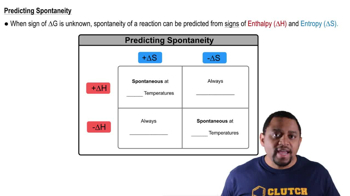Here are the essential concepts you must grasp in order to answer the question correctly.
Gibbs Free Energy
Gibbs Free Energy (G) is a thermodynamic potential that helps predict the spontaneity of a reaction. It is defined by the equation G = ΔH - TΔS, where ΔH is the change in enthalpy, T is the temperature in Kelvin, and ΔS is the change in entropy. A reaction is spontaneous when G is negative, indicating that the process can occur without external energy input.
Recommended video:
Gibbs Free Energy of Reactions
Enthalpy and Entropy
Enthalpy (ΔH) is a measure of the total heat content of a system, while entropy (ΔS) quantifies the disorder or randomness of a system. In the context of a reaction, a positive ΔH indicates that the reaction absorbs heat (endothermic), and a negative ΔS suggests a decrease in disorder. The interplay between these two factors determines the spontaneity of the reaction at a given temperature.
Recommended video:
Entropy in Thermodynamics
Temperature and Spontaneity
Temperature plays a crucial role in determining whether a reaction is spontaneous or nonspontaneous. The temperature at which a reaction changes from spontaneous to nonspontaneous can be found by setting the Gibbs Free Energy equation to zero (G = 0). This leads to the critical temperature T = ΔH/ΔS, allowing us to calculate the temperature at which the balance between enthalpy and entropy shifts.
Recommended video:
Spontaneity and Temperature
 Verified step by step guidance
Verified step by step guidance

